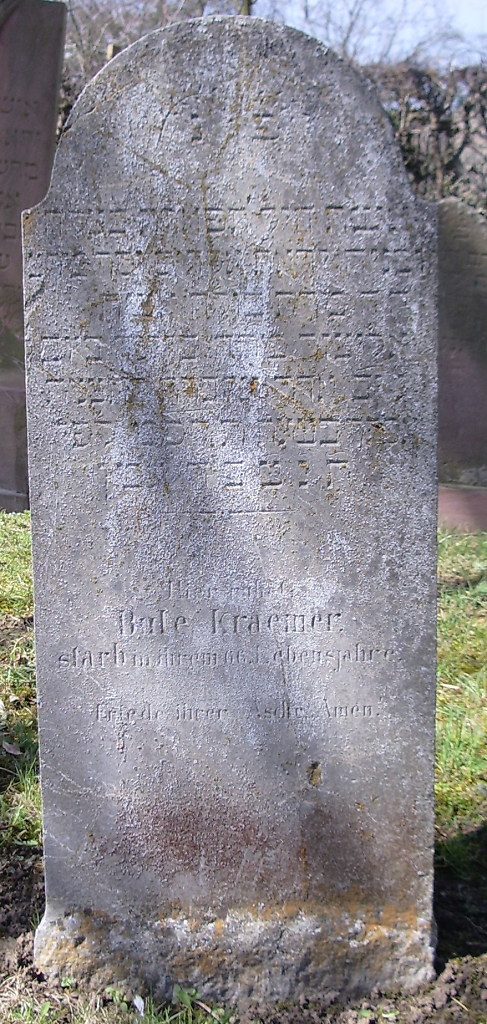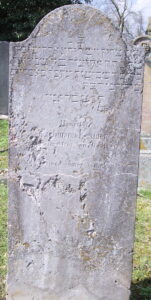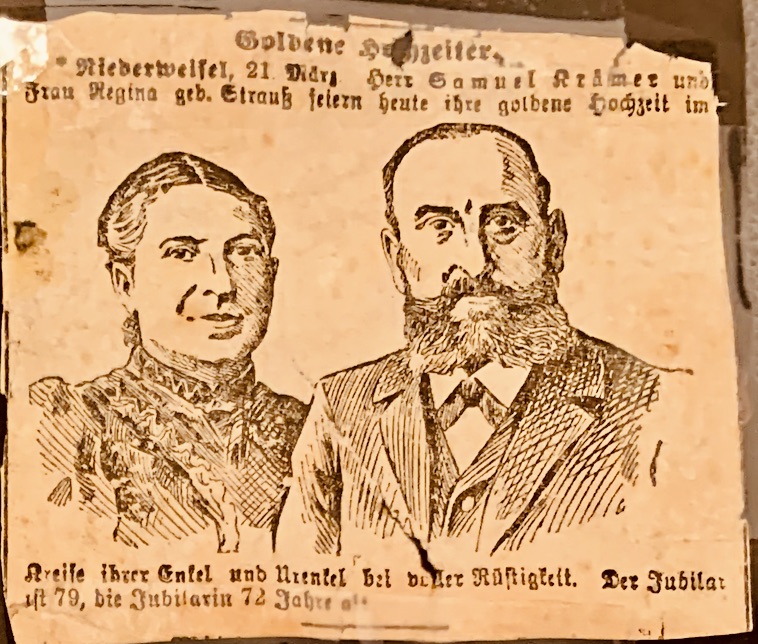For German translation, please see this page
- The Bamberger Family of Muschenheim
- The Family of Julius & Irene (née Mayer) Bamberger
- The Family of Rosa Bamberger, née Borngässer
- The Family of Hugo Mayer of Wohnbach
On 26 September 2023, a Stolperstein will be laid to commemorate Johanna Mayer, née Krämer, in Lich at Kolnhäuser Str. 15 (earlier Butzbacherstr. 19). Johanna lived in Lich from September 1932 until October 1936 at the home of her daughter, Irene, and son-in-law Julius Bamberger.
We can trace Johanna’s ancestors back to at least the late 1700s in the area around the small town of Nieder Weisel in Hesse, about 21 km to the west of Lich. In 1880, just as Johanna was in her infancy, Nieder Weisel was a small town of about 1330 people; the Jewish community numbered 83.1https://www.alemannia-judaica.de/nieder-weisel_synagoge.htm
Johanna’s great-great-grandfather, Samuel Krämer I, was born about 1770. Samuel and his wife, Rebecka, gave birth to son Liebmann in 1803. In turn, Liebmann Krämer married Bettchen Lazarus, who was known as “Bule”, and they lived in Nieder Weisel, forming a family of four: Zerline, Samuel, Abraham, and Löb. In the Jewish cemetery of Nieder-Wiesel, one finds the gravestones of Liebmann (right) and Bule (née Lazarus) Krämer (left).
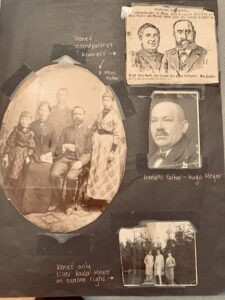
Johanna’s father, Samuel Krämer II, b. 1837, was the second child and first son of Liebmann and Bettchen. In 1864, Samuel married Regina Strauss, and between June 1865 and 1878, they formed a family of six children: 4 daughters and 2 sons. Johanna, b. 1878, was the youngest daughter and the last child. In 1914, Samuel and Regina celebrated their “Golden Wedding Anniversary.” In the early 1920s, they died: Samuel in 1921 and Regina in 1923. Both are buried in the Jewish cemetery of Nieder Weisel.
Johanna lived in Nieder Weisel until 1902 when she married Hugo Mayer. She then moved to his hometown of Wohnbach, about 12 km to the east of Nieder Weisel as the crow flies. Johanna and Hugo had two children, both girls: Irene, b. 1903, and Paula, b. 1907.
In 1926, Johanna’s eldest daughter, Irene, married Julius Bamberger and moved to live in Lich, about 15 km north of Wohnbach. Between 1927 and 1931, a series of deaths clouded the family. In 1927 and again, in 1928, Irene and Julius lost two children, the first was probably a stillborn birth; the second, a daughter, whom they named Inge, lived but a few short weeks in 1928. Then, in January 1931, Johanna’s husband, Hugo Mayer, died; four months later, Johanna’s daughter and Irene’s sister, Paula, died.
On 14 September 1932, Johanna Mayer, age 54, moved from Wohnbach to Lich to live with Irene and Julius. She joined a lively household: a third child, Renate Bamberger, b. 19 July 1930, had reached her second birthday, and her brother, Hugo, was four months old.
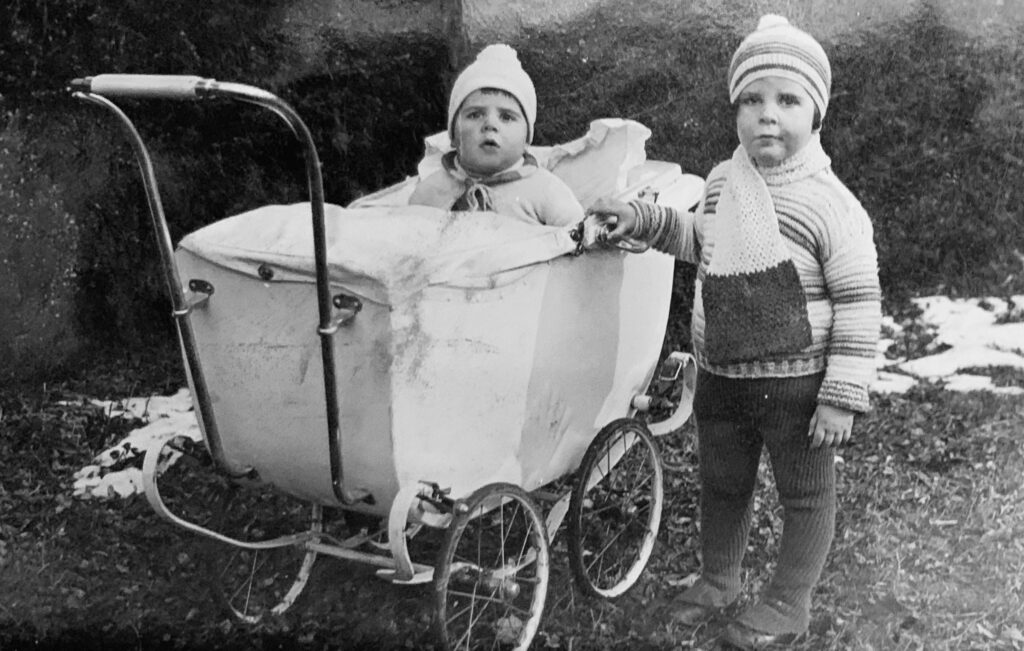
*****
Johanna’s daughter and son-in-law realized early on in the Nazi Regime that they should leave Germany and seek refuge elsewhere. In August 1936, Julius Bamberger was able to leave Germany for South Africa. In October 1936, Johanna left Lich with daughter Irene and grandchildren, Renate and Hugo, and moved to Frankfurt a/Main to be ready to emigrate as soon as possible. They lived in an apartment at Rotteckstr. 10.
In January 1939, Irene, Renate, and Hugo were able to leave Germany with assistance of the Red Cross, but, for reasons unknown, Johanna was unable to accompany them. She moved into Tiergartenstrasse 28 where she lived until November 1941. On 22 November 1941, Johanna was deported from Frankfurt a/Main with a transport of about 990 Jews to Kaunas in occupied Lithuania. The transport arrived on 25 November 1941; the men, women, and children were immediately taken to Fort IX and murdered by the Einsatzkommando. Johanna Mayer, née Krämer, was 63 years old.
The fate of Johanna’s siblings was mixed: Her sister Berta died in 1871; her eldest sister, Rosalie, died of natural causes in 1925. Of those alive when the Nazi Regime began, one sister, Süda, managed to escape from Germany and immigrate into Uruguay. Her brother, Adolf (Abraham) shared Johanna’s fate. A widower since 1928, Adolf moved to Bad Nauheim in July 1938. He was arrested in the Kristallnachtpogrom of 9/10 November 1938 and imprisoned in Buchenwald for five weeks. In March 1940, he left Bad Nauheim and moved to Frankfurt a/Main, possibly hoping that his emigration plans would turn out but, as with Johanna, they did not. Whether he and Johanna lived near each other in 1940 and 1941 is unclear; in 1942, he was living at Hapsburger Alle 16. On 1 September 1942, Adolf was deported from Frankfurt to Theresienstadt Ghetto and from there to the Treblinka Killing Centre on 29 September 1942.
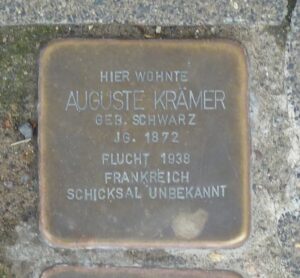 The fate of Johanna’s other brother, Isaak Leopold, is not clear. In 2018, when Stolpersteine were laid for him and his wife, Auguste (née Schwarz), the state of knowledge in Nieder Weisel was that the couple had left Germany in 1938 for France and any trace had been lost by 1942. The Stolpersteine state that their “fate was unknown/Schicksal unbekannt.” The assumption was that they were deported to Auschwitz and murdered. But to date, no records have been found in the German National Archives Memorial Book, Arolsen Archives, or Yad Vashem.
The fate of Johanna’s other brother, Isaak Leopold, is not clear. In 2018, when Stolpersteine were laid for him and his wife, Auguste (née Schwarz), the state of knowledge in Nieder Weisel was that the couple had left Germany in 1938 for France and any trace had been lost by 1942. The Stolpersteine state that their “fate was unknown/Schicksal unbekannt.” The assumption was that they were deported to Auschwitz and murdered. But to date, no records have been found in the German National Archives Memorial Book, Arolsen Archives, or Yad Vashem.
*****
The Descendants List below outlines the family of Samuel and Regina (née Strauss) Krämer. The notice re: their 50th wedding anniversary comes from a scrapbook in the family archive of the Irene (née Mayer) and Julius Bamberger family.
“Golden Wedding Anniversary
Mr. Samuel Krämer and Mrs. Regina, née Strauss, joyfully celebrated today their Golden Anniversary in the circle of their grandchildren and great-grandchildren. He is 79 years old, she 72.”
- Samuel KRÄMER, b. ca 1837 Nieder Weisel/HE, d. 30 Jan 1921 Nieder Stoll/HE
- └ ∞ (18 Oct 1864) Regina STRAUSS, b. 1842 Büdesheim/HE, d. 20 Mar 1923 Nieder Weisel/HE
- 1. Rosalie KRÄMER, b. 12 Jun 1865 Nieder Weisel/HE, d. 06 Nov 1925 Bad Nauheim/HE, buried Muschenheim, Neuer Friedhof
- └ ∞ (21 Jun 1885 Nieder Weisel) K[aufmann] BAMBERGER, b. 03 Mar 1858 Muschenheim/HE, d. 01 Jul 1925 Muschenheim/HE, buried Muschenheim, Neuer Friedhof
- 2. Kathinka BAMBERGER, b. 03 Jul 1886 Muschenheim/HE, d. 27 Apr 1897 Muschenheim/HE, buried Muschenheim Neuer Friedhof
- 2. Pauline (Paula) BAMBERGER, b. 11 Jan 1888 Muschenheim/HE, 1940 Genoa to NY/USA, d. Oct 1979 NYC/NY
- └ ∞ (17 Oct 1907 Lich/HE) Berthold ROSENTHAL, b. 15 Dec 1872 Bad Nauheim/HE, d. 04 Oct 1933 Bad Nauheim/HE
- 2. Isaak BAMBERGER, b. 01 Aug 1890 Muschenheim/HE, d. 16 May 1891 Muschenheim/HE, buried in Muschenheim Neuer Friedhof
- Ludwig BAMBERGER, b. 15 May 1892 Muschenheim/HE, d. 30 Aug 1914 Motzfeld/HE (WWI)
- 1. Isaak Leopold KRÄMER, b. 09 May 1867 Nieder Weisel/HE, 1938 to France, no trace after 1942.
- └ ∞ (05 Dec 1893 Nieder Weisel/HE) Auguste SCHWARZ, b. 13 Mar 1872 Nieder Weisel/HE, 1938 to France, no trace after 1942
- 2. Ludwig KRÄMER, b. 18 Jan 1895 Nieder Weisel/HE, d. 22 Mar 1916 Bois de Malamont, Lorraine/France (WWI)
- 2. Julius KRÄMER, b. 18 Feb 1897 Nieder Weisel/HE, deported 1942 fr Drancy/FR, murdered 07 Aug 1942 Auschwitz/Occupied Poland
- └ ∞ (16 Oct 1925 Nieder Weisel/HE) Irma KRÄMER, b. 05 Mar 1904 Nieder Weisel/HE, deported 31 Jul 1942 fr Pithiviers/FR , murdered Auschwitz/Occupied Poland
- 3. Kurt Karl Siegbert KRÄMER, b. 03 Sep 1926 Nieder Weisel/HE, deported 31 Jul 1942 fr Pithiviers/FR , murdered 19 Oct 1942 Auschwitz/Occupied Poland
- 2. Arthur KRÄMER, b. 02 Mar 1899 Nieder Weisel/HE, 1960 and 1962 fr Cali/CO to FL/USA, d. 18 Jul 1977 Santiago de Cali/Colombia
- └ ∞ Irma SASS, b. 04 Jun 1906 Düsseldorf/NRW, 1960 and 1962 fr Cali/CO to FL/USA, d. 19 Aug 1987 Santiago/Columbia
- 2. Paula KRÄMER, b. 26 Jul 1900 Nieder Weisel/HE, d. 09 Oct 1900 Nieder Weisel/HE
- 1. Berta KRÄMER, b. 14 May 1869 Nieder Weisel/HE, d. 12 Dec 1871 Nieder Weise/HE
- 1. Süda Zita KRÄMER, b. 11 May 1872 Nieder Weisel/HE, d. 10 Jul 1943 Montevideo/Uruguay
- └ ∞ (02 Feb 1906 Nieder Weisel/HE) Hermann STERN, b. 27 Oct 1865 Selters/HE, d. 05 May 1940 Montevideo/Uruguay
- 2. Flora STERN, b. 26 Apr 1897 Selters/HE, 01 Dec 1938 fr Le Havre/FR to NYC/USA, d. 30 Jan 1987 Silver Spring/MD
- └ ∞ (26 Apr 1926 Hachenburg/RP) Robert HANAU, b. 26 Jun 1883 Beau Marais/Saarland, 01 Dec 1938 fr Le Havre/FR to NYC/USA, d. 05 Feb 1973 Brooklyn/NY
- 3. Manfred (Fred) HANAU, b. 19 Jun 1927 Saarlouis/Saarland, 01 Dec 1938 fr Le Havre/FR to NYC/USA
- 2. Paula STERN, b. 13 Oct 1898 Hachenburg/RP, d. Montevideo/ Uruguay
- └ ∞ (12 Apr 1923 Hachenburg/RP) Max Isaak Jacoby, b. 27 Feb 1899 Mannheim/Baden, d. Mannheim/Baden
- 2. Marta STERN, b. 01 Feb 1901 Hachenburg/RP, 1954 to Rio de Janeiro, d. Uruguay?
- 1. Adolf (Abraham) KRÄMER, b. 29 Sep 1874 Nieder Weisel/HE, deported 01 Sept 1942 fr Frankfurt to Theresienstadt, murdered 29 Sep 1942 Treblinka Extermination Centre/Occupied Poland
- └ ∞ Rosalie KAUFMANN, b. 21 Feb 1878 Butzbach/HE, d. 25 Feb 1928, buried Jüdischer Friedhof/Nieder Weisel
- 2. Ludwig KRÄMER, b. 05 Oct 1903, d. 12 Feb 1928, buried Jewish cemetery/Nieder Weisel
- 2. Erna KRÄMER, b. 22 Aug 1906 Nieder Weisel, 28 Aug 1939 into England/Dec 1947 fr England to USA, d. 04 Apr 2008 Baltimore/MD
- └ ∞ (02 Jun 1929 Nieder Weisel) Arthur BÄR/BAER, b. 28 Aug 1905 Griedel/HE, 28 Aug 1939 into England/Dec 1947 fr England to USA, d. 11 Nov 1978 Baltimore/MD
- 3. Erich BÄR/BAER, b. 18 Jul 1932 Nieder Weisel, 28 Aug 1939 into England/Dec 1947 fr England to USA
- └ ∞ (1956) Ana GOLENDER, b. 11 Jan 1934 Buenos Aires, Sep 1947 to USA, d. 11 Dec 1995 Cuyahoga/OH
- 4. Lisa BAER
- 4. Michelle BAER, b. 30 May 1964 OH/USA
- └ ∞ (07 Feb 1999) Phyllis “Anne” HILTNER, b. 18 Mar 1941 Toledo/OH, d. 06 Sep 2010 Cleveland/OH
- └ ∞ (2016) Jane GLAUBINGER
- 1. Johanna KRÄMER, b. 05 Mar 1878 Nieder Weisel/HE, 1932 fr Wohnbach to Lich, Oct 1936 fr Lich to Frankfurt a/M, 22 Nov 1941 deported fr Frankfurt a/Main to Kovno, murdered 25 Nov 1941 Fort IX, Kovno/Kaunas/Occupied Lithuania
- └ ∞ (26 Nov 1902 Nieder Weisel) Hugo Mayer, b. 16 Mar 1876 Wohnbach/HE, d. 30 Jan 1931/Wohnbach/HE
- 2. Irene MAYER, b. 28 Sept 1903 Wohnbach/HE, 1926 to Lich, Oct 1936 fr Lich to Frankfurt a/M, Jan 1939 to South Africa, d. 30 Oct 1957 Johannesburg/South Africa
- └ ∞ (23 Feb 1926) Julius BAMBERGER, b. 7 May 1898 Muschenheim/HE, 18 Aug 1936 to South Africa, d. 26 Dec 1957 Johannesburg/South Africa
- 3. “Child” BAMBERGER, b/d 1927 Giessen/HE
- 3. Inge BAMBERGER, b. 19 Oct 1928, d. 07 Nov 1928 Giessen/HE
- 3. Renate BAMBERGER, b. 19 Jul 1930 Giessen/HE, Oct 1936 fr Lich to Frankfurt a/M, Jan 1939 to South Africa
- For family outline, see here.
- 3. Hugo BAMBERGER, b. 09 May 1932 Giessen/HE, Oct 1936 fr Lich to Frankfurt a/M, Jan 1939 to South Africa, 1993 fr South Africa to USA, d. 29 Jun 2021 Plantation/FL
- For family outline, see here.
- 2. Paula MAYER, b. 04 Aug 1907 Wohnbach/HE, d. 11 Apr 1931 Wohnbach/HE, buried Jüdischer Friedhof Lich
Sources:
Familienbuch Butzbach Band V: Judenfamilien in Butzbach und seinen Stadtteilen. Von Hanno Müller, Dieter Bertram, Friedrich Damrath und Dieter Wolf. Butzbach 2007. S. 59, 112, 119, 121f., 125, 131, 229 (NW-60).
